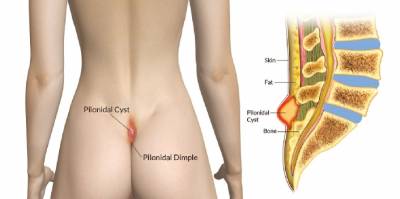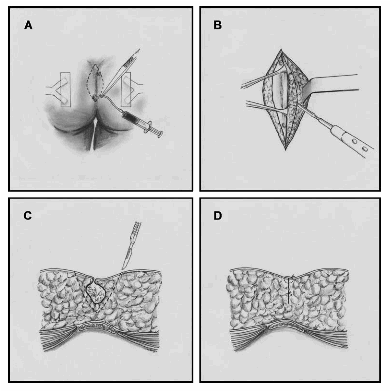Pilonidal Cyst (sinus)
 A pilonidal cyst (pilonidal sinus) is a cyst that develops along the tailbone (coccyx) near the cleft of the buttocks. These cysts usually contain hair and skin debri. Although there are several theories, most researchers today believe that pilonidal cysts are acquired (rather than congenital, or inborn) and are caused by the penetration of loose hairs into the skin. In response to this ingrown hair, a local inflammatory reaction causes a cyst to form around the hair.
A pilonidal cyst (pilonidal sinus) is a cyst that develops along the tailbone (coccyx) near the cleft of the buttocks. These cysts usually contain hair and skin debri. Although there are several theories, most researchers today believe that pilonidal cysts are acquired (rather than congenital, or inborn) and are caused by the penetration of loose hairs into the skin. In response to this ingrown hair, a local inflammatory reaction causes a cyst to form around the hair.
In addition to male gender, other risk factors for the development of pilonidal cysts include a family history of pilonidal cysts, occupations which require prolonged sitting, hirsute (hairy or having copious hair) individuals, and the presence of a deep natal cleft (the cleft between the buttocks). Obese individuals are more likely to experience a recurrence of pilonidal sinuses.
Some individuals with a pilonidal sinus may be asymptomatic, and the only finding may be a dimple or an opening in the skin (sinus tract) in the sacrococcygeal area. However, if the pilonidal cyst becomes infected, the following signs and symptoms may develop:
- Pain over the lower spine
- Redness of the skin
- Warmth of the skin
- Localized swelling over the lower spine
- Drainage of pus from an opening in the skin (sinus tract) over the lower spine
- Fever (uncommon)
Treatment of pilonidal Cyst
Individuals who simply have a dimple or sinus tract that has not become infected or inflamed do not generally require any immediate treatment. However, an infected pilonidal cyst is an abscess that requires incision and drainage (lancing) in order to improve. This procedure can generally be performed in a physician's office in local anesthesia.

For those individuals with recurrent or complicated pilonidal cysts, more invasive surgery may be necessary. Several different surgical procedures may be used in this case, and your plastic surgeon will discuss the various options with you. In general, the major difference between the various surgical interventions centers around leaving the surgical wound open after surgery and allowing it to heal versus closing the surgical wound after debridement using plastic surgery technique’s during the same procedure. In many cases this can be done in the plastic surgeon office in local anesthesia.
Healing time and recovery vary based on the surgical technique used and may range from several weeks to several months.
- Recovery time
- 1-2 weeks
- Price range
- 700-1000 euro
- Anesthesia type
- Local anesthesia














